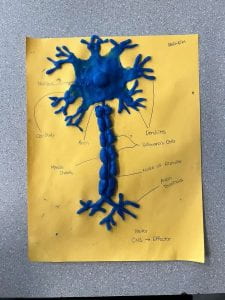May
2023
Psychology 12 – Neuron Communication Summary
Neuron structure:
Parts of a neuron-
- Dendrites: The ends of a neuron that receive neurotransmitters from other neurons.
- Soma (Cell Body): Soma contains the nucleus and directs or keeps the functions of the neuron.
- Nucleus: Contains genetic information.
- Axon: Carries action potentials and conducts nerve impulses from the dendrites or cell body to the synapse.
- Axon Terminal: Releases neurotransmitters when triggered by impulse (the action potential).
- Myelin Sheath: Allows electrical impulses to travel efficiently along the axon.
- Nodes of Ranvier: Gaps in the myelin sheath that expose the axon, allowing action potentials to travel throughout the axon.



Neuron function:
How does the Action Potential get passed through a neuron? There are many stages of action potential, which is defined as a brief electrical charge that travels down the length of the neuron. Action potential is a result of the movement of positive ions into and out of the axon.
- Resting Potential
Na+ (Sodium) ions start outside the axon and K+ (Potassium) begin inside the axon. The presence of large negative ions on the inside gives it an overall negative charge. In this stage the voltage is -70mV.
- Depolarization
The “Gates” in the axon are closed in resting potential, they then open and allow natural flow of sodium into the membrane because: the positive ions on the outside of the axon (Na+) are attracted to the negative ions on the inside, and sodium will move to where it has high concentration to low concentration. The voltage in this stage increases to 30mV because the inside has become more positive.
- Repolarization
The sodium rushes in the gates close and the sodium is stuck, a tunnel for potassium is then opened. Potassium will move to the outside of the membrane because it is in less concentration there. The Voltage will go back to –70mV (sometimes will go lower) because some of the positive ions have exited the membrane. Depolarization can’t occur in this stage because some ions (Na+ and K+) aren’t in their starting position. This stage allows the next section of axon to repolarize
- Refractory Period
During this stage potassium gets pushed outside the membrane, while sodium is put back inside. The ions go back into their starting positions.
- Flow of depolarization
Repolarization in 1 section of the axon will stimulate depolarization in the next section. The impulse for action potential doesn’t travel backwards because of refractory period.
- Action Potential: Speed
The Schwann’s cells are coated in myelin, this wraps around the axon. Neuron fibers that are coated in Myelin have a faster action potential. Action potential travels in the Nodes of Ranvier, not the myelin. This makes the length of the axon shorter, allowing the impulse to travel faster along the neuron fiber.
Synapse function:
How does the action potential from one neuron reach another neuron? A synapse is a junction between two nerve cells where a signal is sent from axon to dendrite. The action potential travels down the axon, to the axon terminal bulb. This causes the synaptic vesicles to move down and merge with the presynaptic membrane, therefore, releasing their inner contents (neurotransmitters). The neurotransmitters are then released into the synaptic gap. They move by diffusion and some of them bind to the receptors on the postsynaptic membrane of the other neuron, while some are recycled and sent back to the axon terminal bulb. When the neurotransmitters bind to the receptors, they send a message that is either received as excitatory or inhibitory. If its excitatory, it will stimulate an action potential on the receiving neuron. If its inhibitory, it will repress an action potential on the receiving neuron. Some neurotransmitters are always excitatory, like Glutamate, while some are always inhibitory, like GABA. However, the effect of most neurotransmitters depend on the receptor that they bind to.
Synapse structure:
